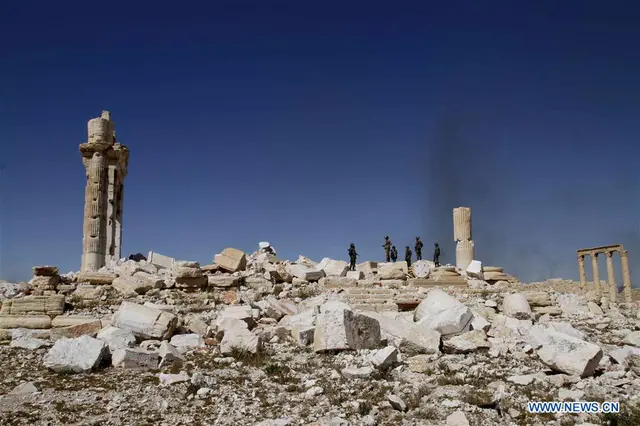Over the past week, the Islamic State (IS) group has lost two important strongholds in central Syria, namely the ancient oasis city of Palmyra and the nearby city of Qaryatain in the eastern countryside of the central province of Homs.
However, the terror group didn't withdraw from the cities before laying down a complicated network of mines.
Black smoke could clearly be seen over the ancient city of Palmyra and Qaryatain, in what was Syrian and Russian sappers demining the boobytraps, hours after the Syrian army forces recaptured them.
Syrian officers spoke about the ongoing efforts to demine the cities, which are considered to be "a military and geographic extension to the presence of the IS terror group in eastern Syria. "
"The main power point for the militants was the mines. The militants had very strong fortifications on the hilltops surrounding Qaryatain and Palmyra. All roads to the cities as well as the sub-routes and the much of the houses were boobytrapped," a Syrian lieutenant colonel told Xinhua in the town of Qaryatain.
He said the mines the IS had planted were very complicated, noting that the bomb squads in the Syrian army were dismantling the boobytraps with the help of Russian sappers, who have arrived recently in Palmyra and started demining the city, which contains 2,000-year-old monuments.
Another officer, who asked not to be named, said the IS planted tens of explosive devices and bombed several buildings in Qaryatain before their withdrawal to thwart the progress of the Syrian army.
In Qaryatain, destruction was everywhere. The city bore the scars of the weeks-long battles, with no civilians inside to tell their stories, as most of them were said to have been herded to the IS de facto capital of al-Raqqa in northern Syria.
Ravaged streets, pancaked buildings and shops punctuated with bullet holes were everywhere. Empty bullet shells were scattered in every corner and street, giving the spectator a picture of how intense the battles were.
The Syrian army boasted the victory of Qaryatain and also attributed such a success, in part, to the supporting Russian air force, whose warplanes heavily pounded the IS positions inside the city until they were flushed out.
Speakers playing national songs could be heard in the battered city, which appeared like a ghost town.
In some parts of the city, the belongings of the IS militants were still in place, such as military boots, booklets and even receipts, boring the slogan of that terror-labeled group.
At the far east of the city, an Syriac monastery was reduced to rubbles, with nothing left of the Christian icons. Beside the monastery, a graveyard for bishops was dug up, with remains of bones and skeletons thrown out of the grave, in what appeared to be the IS searching for gold or Christian icons, which are usually buried with the Christian clergymen.
The IS also used the monastery as a makeshift factory for manufacturing explosive devices.
Even though the city is destroyed, the General Command of the Syrian army said it had restored "peace and security back to the city."
The spectacle was so similar in Palmyra, where the IS also booby-trapped the entire residential part of that ancient city.
A military expert told Xinhua that the IS opts to leave the cities rigged with explosives to inflict hefty tolls among the Syrian soldiers and to render the cities useless, as part of their retaliatory moves.
He said that in Palmyra, the IS connected the detonators of the bombs that were planted in the houses to the main telephone station of the city, adding that the bomb squads discovered the trap and disconnected all landline communication to the city.
The recapture of Palmyra and Qaryatain's strategic importance emirates from their location, as they are a hub linking the northern countryside of the capital Damascus with the eastern countryside of Homs province, Syria's largest.
The Syrian army said that the achievement will secure the oil and gas pipelines in the central region in Syria and will cut the supply lines of the IS from the Syrian Desert toward the Qalamoun region in northern Damascus. Enditem
 简体中文
简体中文

